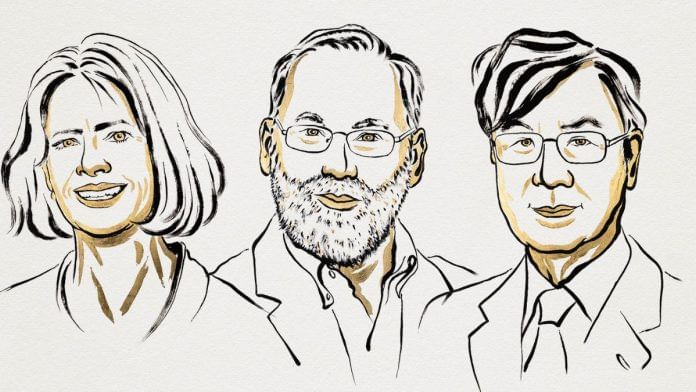New Delhi: Scientists Mary E. Brunkow, Fred Ramsdell and Shimon Sakaguchi were awarded the 2025 Nobel Prize in medicine or physiology Monday for their work in the field of peripheral immune tolerance that prevents the immune system from harming the body.
“Their discoveries have been decisive for our understanding of how the immune system functions and why we do not all develop serious autoimmune diseases,” Olle Kämpe, the chair of the Nobel committee for medicine or physiology, said during the announcement.
The human immune system protects us from thousands of different microbes trying to invade our bodies every day. These microbes have different appearances, and many even develop similarities with human cells—as a form of camouflage—protecting themselves from the human immune system.
The work of this year’s laureates identified the immune system’s peacekeepers—regulatory T-cells—which prevent immune cells from attacking the body itself.
ThePrint explains the discovery that changed the course of our scientific understanding in the field of peripheral immune tolerance and why it won the 2025 Nobel Prize in medicine.
Discovery that won 2025 Nobel Prize in medicine
In Japan, Osaka University professor Shimon Sakaguchi began his work in 1995.
At the time, many of his peers were convinced that immune tolerance developed only when potentially harmful immune cells were eliminated in the thymus, an upper-chest organ functioning as the primary site for the maturation of T-cells, which are crucial to the immune system, via a process called central tolerance.
Scientists knew that central tolerance in the thymus was the process of eliminating or suppressing self-reactive T-cells, thereby preventing them from leaving the thymus and attacking the body’s own tissues.
Shimon Sakaguchi’s work, however, led to the discovery of a new class of immune cells, which demonstrated that the immune system is more complex. The new class of cells in the immune system was found to protect the body, in particular, from autoimmune diseases.
In 2001, Mary E. Brunkow, a PhD student from Princeton University, and Fred Ramsdell, another American who is the director at Parker Institute for Cancer Immunotherapy, stepped up to support his work.
The American scientists discovered why a specific mouse strain was particularly vulnerable to autoimmune diseases. First, they discovered that the diseased mice carried mutations in a gene that they eventually named FOXP3.
Then, they showed that the same mutation in the human equivalent of FOXP3 caused a serious autoimmune disease, IPEX—a rare, X-linked genetic disorder characterised by severe, early-onset systemic autoimmunity.
By 2003, Shimon Sakaguchi could link these two discoveries, proving that the FOXP3 gene governs the development of the new class of immune cells that he identified back in 1995. Those cells—now known as regulatory T-cells—monitor other immune cells and ensure that our immune system tolerates our own tissues, he concluded.
The discoveries were pioneering in the field of peripheral tolerance, leading to the development of medical treatments for cancer and autoimmune diseases. Potentially, the discoveries could lead to more successful transplantations, with some of those processes already undergoing clinical trials.
Additionally, the discoveries hold promise for cures for autoimmune diseases: Type 1 diabetes, multiple sclerosis, and rheumatoid arthritis, among others. They could also improve treatments for different types of cancers and prevent serious complications after stem cell transplants.
The immune system & regulatory T-cells
T-cells are the white blood cells in the immune system that mature in the thymus and are responsible for fighting infections. Helper T-cells constantly patrol the body, ensuring that other immune cells are alerted if harmful microbes invade the body, and killer T-cells eradicate cells infected by viruses and pathogens. Regulatory T-cells provide peripheral immune tolerance, acting as the immune system’s peace-keepers.
The discoveries of this year’s Nobel laureates in the field of medicine have shown that the FOXP3 gene in mice leads to the development of the regulatory T-cells, which, in turn, prevent other T-cells from mistakenly attacking the body’s own tissues.
Regulatory T-cells also ensure that the immune system calms down after it has eliminated invading microbes, so that the system does not continue working, the Nobel Prize-winning scientists have found.
“The fundamental knowledge that researchers have gained through the discovery of regulatory T-cells and their importance for peripheral immune tolerance has spurred the development of potential new medical treatments,” the Nobel Committee said on Brunkow, Ramsdell, and Sakaguchi’s work.
“Mapping of tumours shows that they can attract large numbers of regulatory T-cells that protect them from the immune system. Researchers are therefore trying to find ways to dismantle this wall of regulatory T-cells, so the immune system can access the tumours.”
(Edited by Madhurita Goswami)
Also Read: Subrahmanyan Chandrasekhar’s stellar limit was called absurd. It got him 1983 Physics Nobel






